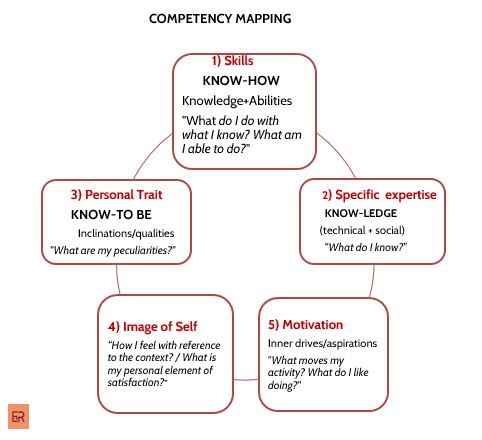
10 October 2023 Skills: discover what they are and how to map them
Skills mapping for a useful personal and company balance sheet
Competencies: what they are
Competencies: what are they? A good question to answer when you want to start a personal and a company assessment.
To answer this question, several elements must be considered.
The word Competency, in common usage, expresses the "level of knowledge and ability in performing activities".
This definition, however, is rather restrictive as it does not immediately recall the 'inner drive' and motivation that is also part of competence. In fact, in the competency, five distinct elements are identified as contributing to its formation.
The 5 elements of competency
The five elements that contribute to the formation of competency are:
1) SKILLS, 2) KNOWLEDGE, 3) PERSONAL TRAIT, 4) IMAGE OF SELF, 5) MOTIVATION
Each of these elements has a specific way and value of expression and development. Moreover, these are all important factors to be taken into account both in the recruiting of a new employee and during a company mapping.
The first 3 elements concern one's KNOWLEDGE and therefore what one learns by following personal inclinations and training in life experiences. The 4th and 5th elements instead refer to the own ESSENCE and IDENTITY matured with respect to the social and cultural environment that influences all human existence.
When speaking of competency the reference is often exclusively to specific and technical knowledge, forgetting that in order to express it effectively, a certain amount of know-how (skills) and motivation are also needed.
Furthermore, we don't focus enough on the fact that in order to know-how, which means expressing one's knowledge and skills, it is necessary to both enter into relationship with other people, and to have a clear reason to do so, activating one's actions accordingly.

For an employee starting a personal competency assessment to draft their CV, keeping in mind all the 5 elements of competency can help to become more aware of their entire cultural and life background and, possibly, choose where to further invest their energies in order to continue increasing their future preparation.
It should be emphasised that the alignment between company and skills does not occur automatically.
It is therefore useful and necessary, both on the part of the organisation but also on the part of present and future co-workers, understand and listen to each other's peculiarities, expectations, and needs.
The 5 steps for company mapping
The process steps of a company competency mapping could be broadly summarised as follows:
- Identify and distinguish in the job 'profile' the technical aspects, specific to the position/role, from the "cross-functional" ones skillsThese aspects are called "cross-functional" because they can be identified in several job positions with similar characteristics (e.g. in all managerial roles or in all leadership roles, etc.).
- Include in the job competency requisite also requirements that allow the aspects of context and personal aspiration to be grasped.
- Define the types and scale of measurement, expressed with reference to dimensions of adequacy (0-5) or in qualitative descriptive terms (e.g. insufficient/sufficient/fair/good).
- Deliver questionnaires and interviews through questionnaires and subsequent interviews. This step is an important moment for the integration of nuances and details of behaviour at work that may be somewhat implicit. Stakeholders may include first & second level managers and possibly, depending on the extent of the mapping, some peers as well.
- Process the collected information and share the data with the company process mapping persons for the elaboration of the measures to be initiated.
Based on any gap identified in the level of competency, the areas for improvement with the specific change management actions are defined. In addition, an individual development plan for specific employees is also put together in order to support evolution and growth.
What to consider when mapping corporate competencies
Different competencies specifically sought for by a company in their employees originate from the Mission/Vision/Values of the company and from the expectations of the organisation as a whole.
The set of behaviours and the way in which the work activity is performed by the employees create the corporate culture and represent the distinctive traits of the company.
Some distinctive elements of the corporate culture are:
- the nature of the business;
- the unique qualities of the product/service that differentiate with reference to the economic environment;
- the ways of facing the external context;
- the relations with stakeholders;
- the corporate priorities and expectations;
- the leadership and management styles (-> behaviours);
- the recruiting & staffing processes;
- the rules, codes, policies, structures, technologies, more or less codified operation systems;
- the type of organisational processes (e.g. lean, agile..) on which to measure customer satisfaction.
Different differentiating features of the company, the organisation needs and competencies are all components that need alignment in order to create the ideal corporate structure, so that the work activities can be carried out properly.
Mapping the competencies is therefore a key business activity and also necessary in all cases where the company is faced with large changes dictated to external factors (e.g. technological development, globalisation, emerging economies, demographic trends) or internal factors (e.g. changes in product/service lines, mergers, downsizing).
Mapping the competencies of its employees means for the company re-discover its structure and ideal shape.
On the one hand, the mapping allows benefiting more from the skills already present in the organisation and, on the other, to get more proactively involved in case of need to add or increase a competency.
Competency mapping: what usefulness
Understanding the different aspects of competency and initiating a company or personal mapping process is a rather complex matter.
- As far as the company is concerned, the mapping of competencies is a dynamic activity to periodically review and realign the employees’ skills & features. In this way the possibilities of growth of the organisation and the development expectations of employees are both met, generating a double shared value.
- As far as the employee is concerned, from time to time, doing a personal competency mapping helps to keep competencies up-to-date and provide meaning to the work activity, also renewing personal motivation.
What are your competencies? How do you express them?
To deepen and initiate together a personal skills assessment through individual counselling or a company skills mapping project
For an exercise to reach an awareness of personal competencies and develop additional skills
https://helenemindfulcoach.com/la-consapevolezza-come-strumento-di-lavoro/
